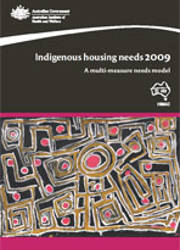Summary
Indigenous housing needs 2009: a multi-measure needs model is the second report published on Indigenous housing needs. A multi-measure approach comprising five dimensions endorsed by the Housing Ministers' Conference (HMC) is used to determine Indigenous housing need. The report presents the most recent data on the level of Indigenous housing need across the five dimensions of homelessness, overcrowding, affordability, dwelling condition and connection to essential services; estimates the current dwelling need gap; and provides projections of Indigenous housing need.
At 30 June 2006, the estimated resident Aboriginal and Torres Strait Islander population was 517,200, or 2.5% of the total Australian population. An estimated one-third (32%) of Indigenous Australians were living in capital cities and a further 43% in regional areas. The majority of Indigenous households are family households (81%), are larger than non-Indigenous households, and more than half (60%) were renting.
The findings
The level of Indigenous housing need was highest in the homelessness, overcrowding and affordability need dimensions.
- 9,248 Indigenous people were experiencing homelessness; 20,739 Indigenous households were overcrowded; 8,331 Indigenous income units were in financial housing stress.
- Overcrowding rates are highest in the Northern Territory and affordability need is more prominent in Major city areas.
- The Indigenous population is in higher need than the non-Indigenous population across homelessness and overcrowding.
- The number of additional dwellings required to help those in most need across the three dimensions was estimated to be 9,795.
The number of dwellings required to meet Indigenous housing need will continue to increase because of demographic growth and changes in household formation.
- It is estimated that in 2006 the dwelling need gap was 11,538 dwellings, considering extreme need only, or 19,429 if considering all need.
- It is estimated that in addition to the established dwelling need gap, an estimated additional 529 dwellings were required in 2008 for those in most need, with a further 3,137 dwellings needed by 2018.
- The majority of dwellings are required to reduce overcrowding.
Since the 2005 report, connection to essential services and levels of overcrowding have improved.
- However, homelessness and affordability levels have remained the same and dwelling condition has deteriorated.



